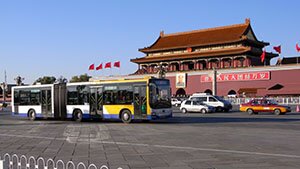
Air pollution, congestion, traffic accidents – the list of negative effects of the constantly growing volume of vehicle traffic in Beijing is long. Despite several policies that restrict vehicle registration and usage, between 2010 and 2014 alone the number of private passenger cars in the Chinese capital Beijing grew from 4.5 to 5.6 million vehicles. This makes transport also a major contributor to greenhouse gas emissions. But during the same time the vehicle fleet growth rate also lowered from ten to three percent annually demonstrating some first success of urban transport policies in Beijing. One promising approach to reduce emissions is transport demand management (TDM) attempting to control demand through measures to reduce the need to travel by car (avoid) and move car drivers to sustainable modes (shift). It is an integral part of sustainable urban transport strategies and is complementary to better urban planning and clean vehicles.
With the aim to support the Beijing Municipal Commission for Transportation in developing and evaluating the impacts of TDM strategies the Deutsche Gesellschaft für Internationale Zusammenarbeit (GIZ) and the Beijing Transport Research Centre (BTRC) jointly implemented the project “Transport Demand Management in Beijing – Emission Reduction in Urban Transport”. The four year project ended in 2015 and has been funded by the German Federal Ministry for the Environment, Nature Conservation, Building and Nuclear Safety (BMUB) in the context of the international climate initiative (IKI).
One of the key tasks of the project was the set-up of an emission quantification tool for urban transport (China Road Transport Emission Model / HBEFA China). Corresponding to the methodology of European cities a systematic evaluation tool to measure and compare environmental effects of changes in transport demand was developed during the project. The tool connects to travel demand models used by transport planners and allows planners to evaluate impacts of urban transport policies e.g. parking management on emissions. It also allows to build up emission inventories that give detailed information about transport related GHG and air pollutant emissions for every urban road. This e.g. is used for identifying emission hotspots in cities.
Comprehensive analytical and conceptual work was required to set up the model. To be able to adapt emission factors from the European Handbook of Emission Factors for Road Transport (HBEFA) to the Chinese traffic conditions the project has collected and evaluated 2000 hours of GPS data from taxis in Beijing and Shenzhen. Today, experts from the Beijing and other Chinese cities are applying the emission model independently and with high technical proficiency. A number of workshops, trainings and study tours with German and European technical experts were organised to build the required capacities. Five cities with a total of 57 million residents were advised on the implementation of the emission model. The City of Shenzhen successfully implemented the model and publishes the data in real-time. Shenzhen also evaluated the impacts of parking management and introduced comprehensive approach in 3 pilot areas in early 2015. The citywide introduction will save 2 million tons of CO2 between 2015 and 2020.
Also in Beijing suitable transport demand management policies were discussed and analysed in regards to their emission reduction potential for Beijing. By way of example, a city congestion charge – known from Stockholm and London – has been evaluated and the implementation process discussed with various international experts. Further, the impact on emission reductions was analysed in different scenarios. Even if unlikely to be implemented in near future, a distance-based charge of 2 RMB/km showed the largest potential to reduce travel demand by about 10 percent and GHG emissions by 12.5 percent. The higher reduction in terms of GHG emission is due to reduced congestion and less polluting stop-and-go traffic.
To further disseminate the learnings, other cities like Tianjin, Chengdu, Suzhou or Harbin were approached in cooperation with World Bank and the China Academy of Transport Science (CATS). In the context of a 18 million USD project sponsored by the Global Environmental Facility (GEF) the HBEFA-China tool is now applied to set-up transport GHG emission inventories and evaluate sustainable transport measures to reduce GHG emissions of urban passenger transport. In this context, experts of CATS – a think tank under the Chinese Ministry of Transport – have been trained to quantify emissions and is going to further disseminate the emission model in their work.
In cooperation with the TRANSfer Project that supports development of ‘Nationally Appropriate Mitigation Actions’ in the transport sector, a training on how to quantify urban transport emissions has been developed and pilot tested in 2014 at the International Transport Forums annual conference in Leipzig. Participants came from Costa Rica, Indonesia, Peru, the Philippines, South Africa, Thailand and Tunesia. In China, GIZ continues to work on urban transport and emissions in the context of the newly established “Sino-German Cooperation on Low Carbon Transport” (CLCT) which has been kicked-off in March 2015. The project is again funded through the International Climate Initiative of the German Ministry for Environment and now partners with the Chinese Ministry of Transport to quantify and reduce carbon emissions from transportation.
Please find the project publications and achievements listed below. Also available as download:
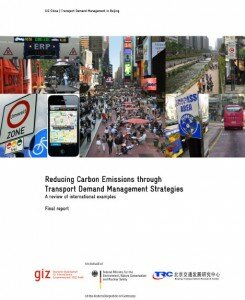
Reducing Carbon Emissions through Transport Demand Management Strategies
The aim of this report is to discuss the potential of TDM strategies to contribute to climate change mitigation and identify the most promising options for Chinese cities. Prerequisites for a successful implementation are discussed and international examples given.
Download here
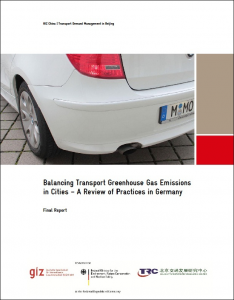
Balancing Transport GHG Emissions in Cities
The guide explains the basis methodology behind the calculation of transport GHG emissions. Emission factor databases and inventory models used in Germany are presented. It further explains GHG balancing methods applied in Germany.
Download available in EN and CN
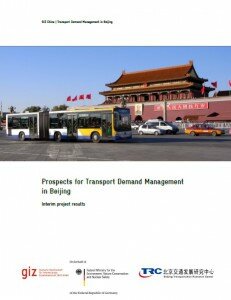
Prospects for Transport Demand Management in Beijing
This report is a key deliverable in the project work stream 1 (TDM policies and measures) and proposes potential and appropriate TDM polices and measures that reduce GHG emissions and achieve considerable co-benefits towards a sustainable urban transport development. It summarises key results and recommends focal areas.
Download available in EN and CN
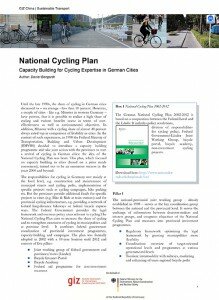
Factsheet Cycling Expertise
Factsheet on the Germany national cycling plan.
Download here
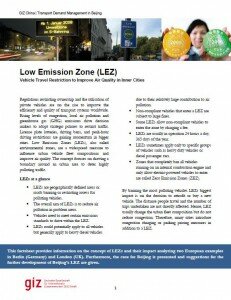
Low Emission Zones – Vehicle Travel Restriction to Improve Air Quality in Inner Cities
Different cities across the world have introduced Low Emission Zones to manage air quality in urban areas. The factsheet explains the policy design and gives some examples from implemented LEZs.
Download available in EN and CN
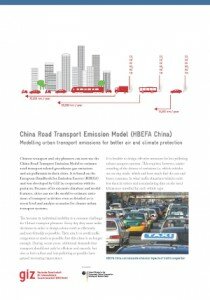
China Road Transport Emission Model (HBEFA China)
Factsheet for the China Road Transport Emission Model.
Download available in EN and CN
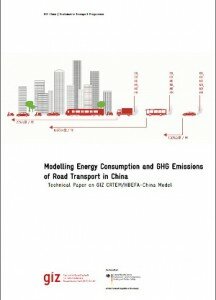
Modelling Energy Consumption and GHG Emissions of Road Transport in China
This technical paper describes the China Road Transport Emission Model. The emission quantification tool has been adopted through the localisation of emission factors and local driving cycles. It is based on the European transport emission model.
Download here
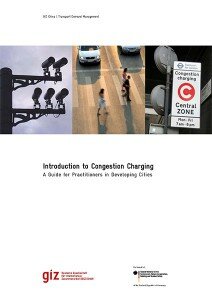
Introduction to Congestion Charging – A Guide for Practitioners in Developing Cities
A joint GIZ and ADB publication on the policy development process for Congestion Charging in developing cities. The guide provides practical recommendations for policy makers and a number of case studies including Stockholm, London and Singapore.
Download available in EN and CN
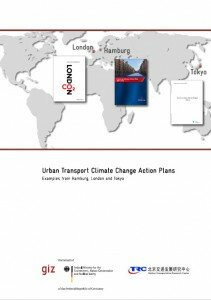
Urban Transport Climate Change Action Plans
The paper gives access to the transport chapters of Hamburg, London and Tokyo and thereby presents good case practices of linking greenhouse gas mitigation objectives with concrete policies and measures in the transport sector – and presents those to decision-makers in China and abroad.
Download here
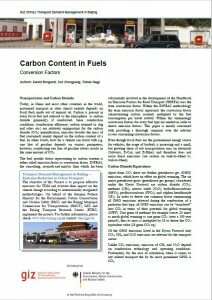
Carbon Content in Fuels – Conversion Factors
Published by GIZ China, the fact sheet “Carbon Content in Fuels – Conversion Factors” provides an introduction into transportation and carbon oxide, presents country-specific carbon contents as well as carbon dioxide equivalents. Furthermore a comparison between tank-to-wheel and well-to-wheel is given.
Download here
Contact:


